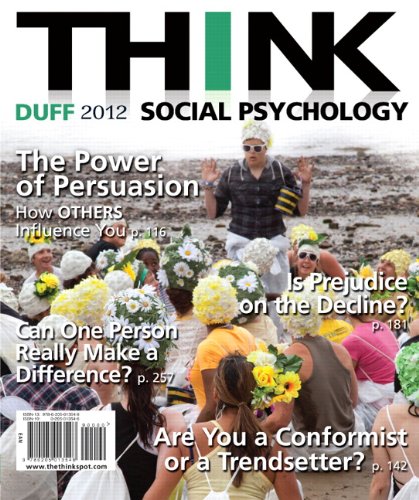This is completed downloadable of Solution Manual for THINK Social Psychology 2012 Edition by Duff

Product Details:
- ISBN-10 : 0205013546
- ISBN-13 : 978-0205013548
- Author: Kimberley Duff
THINK Social Psychology covers the essentials every social psychology student should know. The chapters are briefer than a standard introductory text, allowing for a lower cost to students and using less printed paper. THINK Social Psychology includes 13 chapters of content, giving instructors the flexibility to choose what they want to cover.
THINK Social Psychology provides currency and relevance through design, current examples and high-interest readings. The readings have been chosen from a range of well respected journals and popular press publications. With the concise presentation of material in the chapters, instructors have the option of incorporating these readings and helping students connect to issues occurring outside of the classroom.
An engaging visual design developed with the benefit of extensive student feedback will appeal to students and deliver the key concepts of Social Psychology in a way they can understand.
Table of Content:
Chapter 1: What is Social Psychology
What is social psychology?
What are the roots of social psychology?
What are the different perspectives of social psychology?
Is social psychology just common sense?
Chapter 2: The Science of Social Psychology
How can research methods impact you every day?
How do social psychologists find the truth?
What can descriptive methods show us?
What do experimental methods have to say?
Chapter 3: Social Cognition: Thinking About the Social World
How do schemas guide the way you think about the world around you?
How effective are mental shortcuts?
What are other sources of bias in social cognition?
Chapter 4: Who Am I and How Do Other Individuals See Me?
What is self-concept and where does it come from?
In what ways does our need for self-esteem motivate our actions?
How do we present ourselves to others?
Chapter 5: Social Perception: How Do We Perceive Others?
To what do we attribute people’s behaviors?
How do we decide what other people are like?
Nonverbal Communication: How do we communicate without words?
Chapter 6: Attitudes: Making Evaluations About the World
How do attitudes develop?
Do attitudes influence behavior?
When does behavior influence attitudes?
Chapter 7: The Art and Science of Persuasion
What are persuasive messages and which are the most effective?
What does research tell us about resisting persuasion tactics?
When shouldn’t we resist persuasion?
Chapter 8: Social Influence: Should We Resist?
How do social roles and social norms define the ways in which we behave?
What factors affect and promote conformity?
What methods do people use to get others to comply with requests?
How do authority figures get us to obey them?
Chapter 9: The Power of the Group
What defines a group?
How does a group influence individual behavior?
How does a group make decisions?
How are conflicts among groups solved?
Chapter 10: Stereotypes, Prejudice, and Discrimination: Causes and Consequences
What are stereotypes, prejudice, and discrimination?
How can we measure stereotypes, prejudice, and discrimination?
What are the sources of stereotyping and prejudice?
What are the consequences of stereotyping?
How can we combat stereotyping and prejudice?
Chapter 11: Aggression
What is the nature of aggression?
What are the theories of aggression?
What influences aggression?
How can we reduce aggression?
Chapter 12: Examining Attraction and Close Relationships
What leads to attraction?
How do early parent-child interactions impact future relationships?
What factors influence and define romantic love?
How are relationships maintained?
What role does conflict play in relationships?
Chapter 13: Prosocial Behavior: Why We Help and Why We Don’t
Why do we help?
When do we help?
What are other influences on helping?
How can we increase prosocial behavior?





